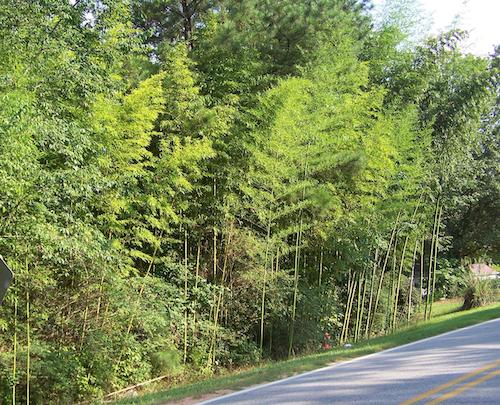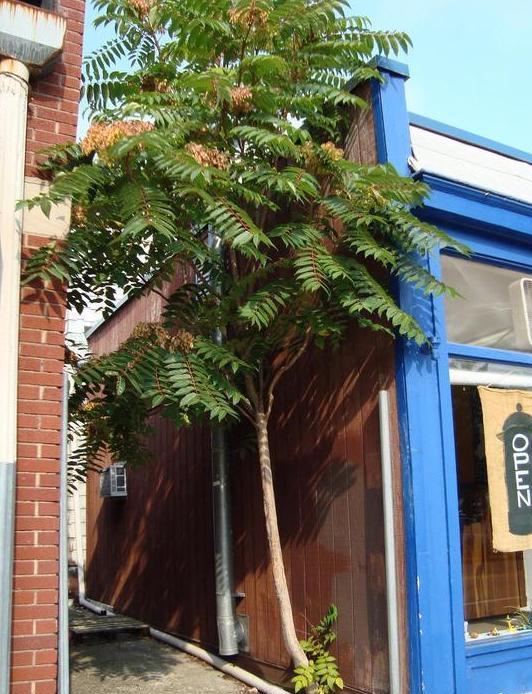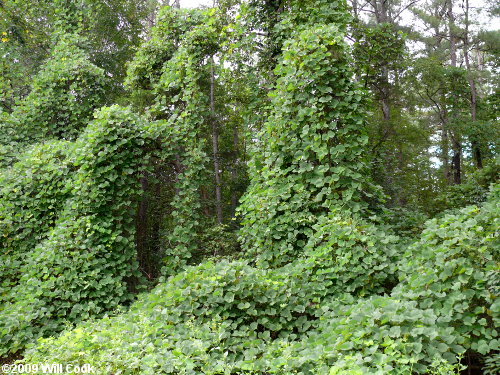Invasive Plants Defined
excerpts from paper by Jennifer Gagnon, Extension Associate, Forest Resources and Environmental Conservation
Virginia Cooperative Extension, Virginia Tech, and Virginia State University

Invasive Bamboo
What is an Invasive Plant?
“Invasive plants pose a serious risk to ecosystems in Virginia. These plants are non-native, have been introduced to new ecosystems by humans, and cause damage to the economy, the environment or to human health. They are costly to control, reduce productivity, can grow faster than native species, and spread quickly. Invasive plants can be trees, shrubs, grasses, or other herbaceous species. There are many species of invasive plants that threaten Virginia’s forests and landscapes, as well as tools to help identify and combat these species.”
-Invasive Plants in Virginia, Virginia Department of Forestry
Economically, exotic invasives cost the United States over $120 billion annually (Pimentel et al. 2005). Costs arise from decreased productivity and expenses associated with control efforts. Exotic invasives come in all shapes, sizes, and kingdoms. There are exotic invasive mammals, fish, insects, crustaceans, mollusks, bacteria, fungi, plants, and viruses. This publication will focus on exotic invasive plants. Virginia has over 90 species of exotic invasive plants.
What Makes Them Invasive?
So, what makes exotic invasive plants exotic and invasive? In general, they are species introduced (intentionally or unintentionally) from somewhere else that flourish in their new environment. They all tend to share certain characteristics that help them excel at being exotic and invasive. These include:
A lack of natural predators in their new environment. Most species that are invasive in their introduced location are not invasive in their native range. There is something in their native range that keeps them in check. This might be competition with other plants, soil conditions, weather, an insect or disease, or likely a combination of factors. Unfortunately, when exotic invasives are brought here, the controlling agents typically are not.

Tree of Heaven
Prolific reproduction. Exotic invasives tend to be extremely good at reproducing. An example is ailanthus or tree-of-heaven (Ailanthus altissima). A single female tree can produce over 300,000 seeds a year.
Multiple means of reproduction. Some species are able to reproduce in more than one way. For example, the aquatic invasive plant, hydrilla (Hydrilla verticillata), has four means of reproducing. New plants come from fragments of mature plants, tubers, turions (detachable buds), and seeds.
Excellent dispersal. A key element of being an invader is the ability to spread across the landscape. The exotic invasive shrub, autumn olive (Elaeagnus umbellata), produces juicy, nutritious berries that are eaten and dispersed by wildlife.
Adaptability. Many exotic invasives are generalists and are able to grow and live under a wide variety of soil, moisture, and light conditions. The exotic mile a minute vine (Persicaria perfoliate) invades a wide- variety of habitats, from forest openings to stream sides.
Early arrival. Exotic invasive plants tend to be pioneer species. They quickly occupy sites that have been recently disturbed. Japanese stiltgrass (Microstegium vimineum) is a good example of an invader that fills in on disturbed soils along hiking trails, rights-of-way, and logging roads. As parcelization and fragmentation (land use change) occur across Virginia, these disturbed areas increase.
Ecological Impacts
Exotic invasive species have negative ecological impacts. These may include:
Altered forest structure. Heathy forests have a vertical structure that includes ground cover vegetation, shrubs and young trees, and an overstory canopy. This vertical structure is important for diversity of both plants and animals. An exotic invasive like kudzu (Pueraria lobata) can eliminate this vertical structure by covering up and pulling over shrubs and trees, resulting in a mat of vines with little vertical structure.

Kudzu
Altered ecosystem function. Exotic invasives change how our native ecosystems function. For example, English ivy (Hedera helix) is an exotic invasive (and widely-planted) vine that climbs up large trees, eventually taking over their canopies and killing them. The result is similar to that of kuzdu; eventually, all that remains is a mat of vines.
Reduction of native species. Because of the aforementioned characteristics, exotic invasive species can out-compete slower-growing, less prolific, native species. And sometimes they get help from an opportunistic native species, the white- tailed deer. Deer will selectively browse on native plants, while leaving the non-natives alone. This gives the exotics an additional advantage.
Decreased productivity. Timber and native wildlife production on sites overtaken by most exotic invasive species will decrease, as native species often do not compete well with exotic invasives.
Decreased biodiversity. In areas inundated with exotic invasives, there is typically a significant diversity loss as natives are pushed out and one or several exotic invasive species take over.
Some funding was obtained in Virginia for the purpose of managing invasives. However, in Fairfax County, the Invasive Management Area Program is a volunteer organization that is being inundated with requests for invasive removal. Check them out if you would like to volunteer or want more information.
Do not plant invasives! You are creating a problem for the next generation, your community and the country.
- References
- Exotic Invasive Plants, Jennifer Gagnon, Extension Associate, Virginia Cooperative Extension, Virginia Tech, and Virginia State University.
- Invasive Plants in Virginia, Virginia Department of Forestry
- Virginia Invasive Species, Commonwealth of Virginia
- Invasive Species Plant List, Virginia Department of Conservation and Recreation